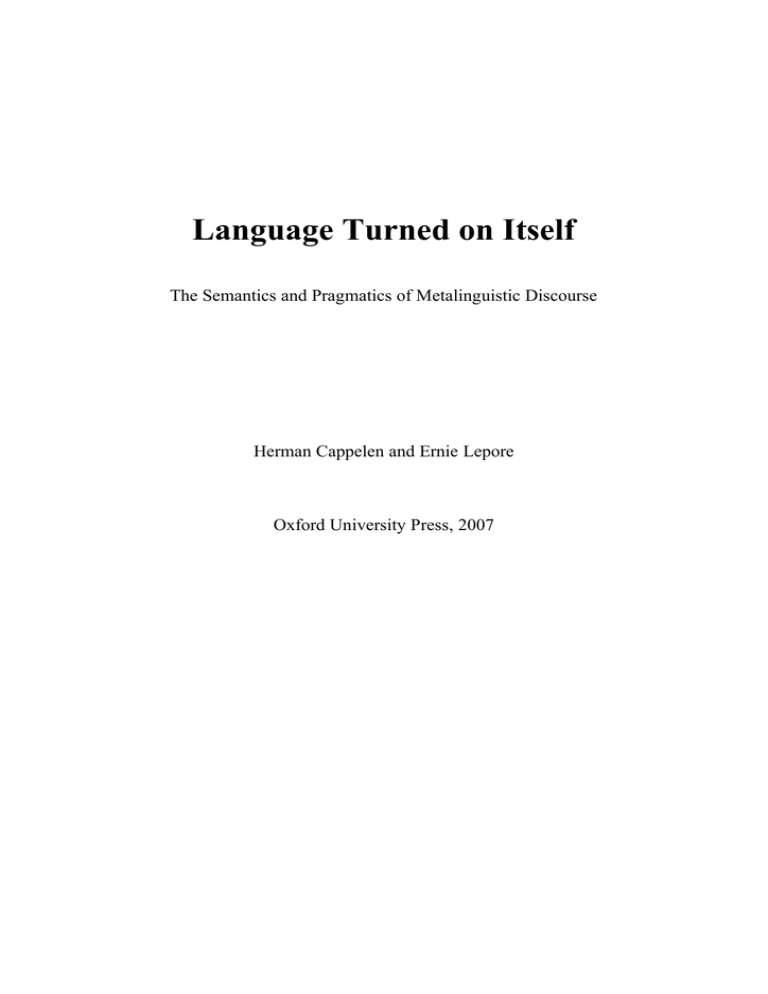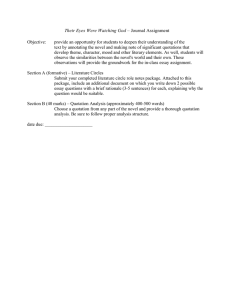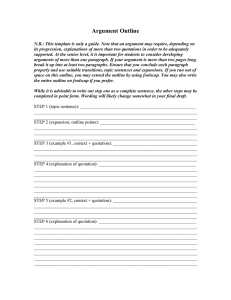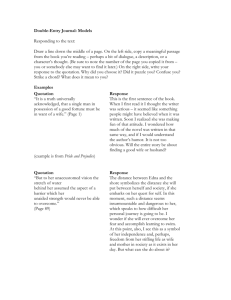Language Turned on Itself
advertisement

Language Turned on Itself The Semantics and Pragmatics of Metalinguistic Discourse Herman Cappelen and Ernie Lepore Oxford University Press, 2007 Contents PREFACE AND ACKNOWLEDGEMENTS CHAPTER 1: ADVERTISEMENT CHAPTER 2: PRELIMINARIES: 'QUOTATION' AND VARIETIES OF QUOTATION Part I: Data CHAPTER 3: OVERVIEW Chapter 4: Omitted Quotation Marks CHAPTER 5: 'IMPURE' DIRECT QUOTES CHAPTER 6: MIXED QUOTATION CHAPTER 7: QUOTATION AND CONTEXT SENSITIVITY Part II: Theory CHAPTER 8: USE THEORIES OF QUOTATION CHAPTER 9: PROPER NAMES AND DESCRIPTION THEORIES OF QUOTATION CHAPTER 10: DAVIDSON'S THEORY OF QUOTATION CHAPTER 11: MINIMAL THEORY OF QUOTATION CHAPTER 12: ON THE NATURE OF QUOTABLE ITEMS BIBLIOGRAPHY Preface This book is about what happens when language turns on itself, when it becomes self-reflective. Those of us who think, talk and write about language are compulsive users of various metalinguistic devices, but reliance on these devices begins early. Kids are told, ‘That's called a ‘rabbit’’ or ‘She is not called ‘spunipta’, she's called ‘Anita’’. It's not implausible that a primitive capacity for the metalinguistic kicks in at the beginning stages of language acquisition. But no matter when or how frequently these devices are invoked, one thing is clear: they present theorists of language with a complex data pattern. We hope, at a minimum, to convince you that the study of these devices and patterns are not only interesting, but also carry important consequences for other parts of philosophy. The history of the topic dates back at least to the origins of analytic philosophy. We find nascent theories of quotation in Frege and Wittgenstein. It is touched upon in various ways by other leading figures such as Tarski, Godel, Carnap, Church, Reichenbach, and Quine. It is not, however, much of an exaggeration to say it became a serious topic of investigation only after Davidson's classic paper on quotation was published in 1979. Much of our earlier work on this topic is devoted to defending a version of Davidson's view. We have, however, become convinced that our earlier Neo-Davidsonean position is fundamentally mistaken; so from a personal perspective this book represents a dramatic intellectual development: it is a systematic attempt to demolish positions held by our earlier time-slices. But those time-slices are not our only targets. The entire current literature on these topics is misguided. In the last two chapters of this book, we present a novel theory – this time with more humility and considerably more reservations than in our earlier attempts. Our primary goal is not, however, to push one theory over another on our readers. Most of all we find the data fascinating and think of this book as an introduction to the subject matter for those unfamiliar with it. It is important to set out the data without the 'noise' of theory; hence, the structure of the book. In Part I, before any theories are even mentioned, five chapters are devoted solely to presenting data about various aspects of our metalinguistic practices. Since there is such a high level of complexity at the data level and any interpretation of that data will depend on prior theoretical commitments (about semantics, pragmatics and syntax), we doubt that there is one uniquely correct way to put it all into a coherent theory. In Part II, we turn to theory, first exposition and then criticism. And in the final two chapters, we present our current effort to weave an adequate account of quotation everywhere it occurs, though even this story we consider a work in progress.




